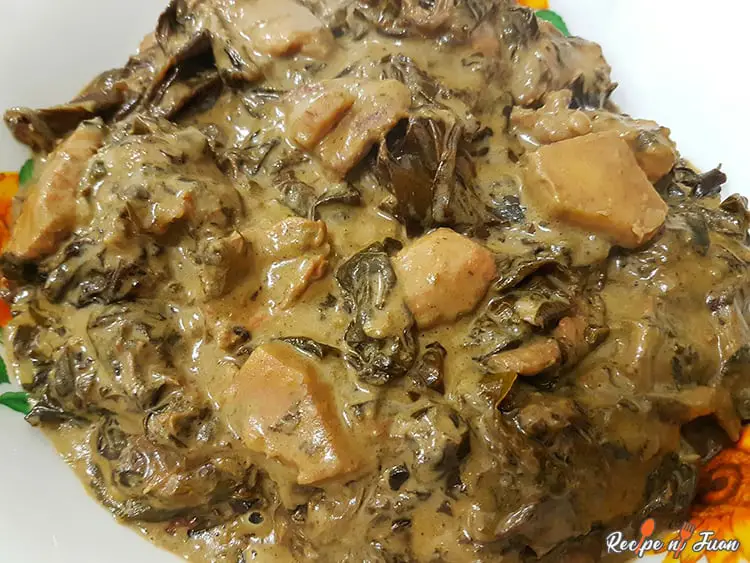Laing recipe: Filipino dish with taro leaves in coconut milk
Laing is also known as taro leaves cooked in coconut milk and chilis. It’s a spicy vegetable dish that’s widely cooked in the Bicol region in the Philippines!
Taro (or gabi) grows well along riverbanks and can be harvested by almost anyone who wants to prepare this laing recipe.
The countryside style of cooking the taro leaves is by shredding them finely and cooking them in palayok or earthen clay pots.
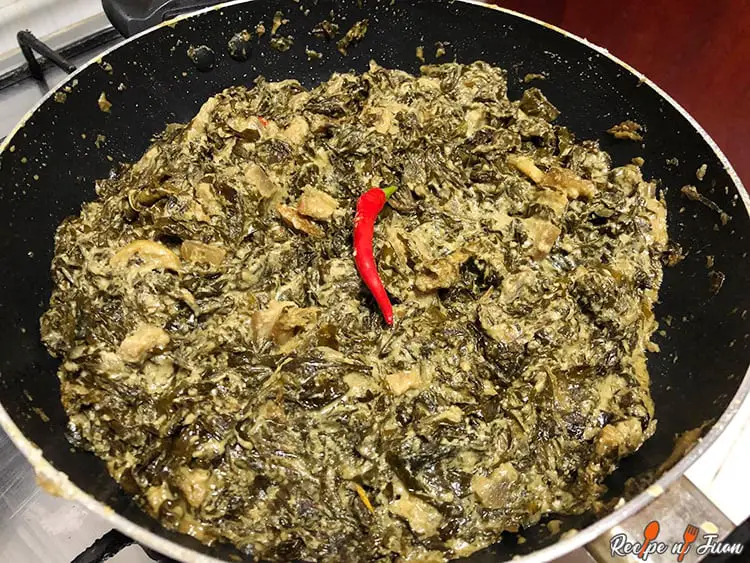

Check out our new cookbook
Bitemybun's family recipes with complete meal planner and recipe guide.
Try it out for free with Kindle Unlimited:
Read for freeIn this post we'll cover:
Laing recipe and preparation tips
If you happened to purchase fresh gabi leaves, don’t use them immediately. The taro leaves need to be sun-dried for at least a day.
The taro stems are then peeled and the leaves should be shredded using your hands.
Using a stainless steel knife when cutting the taro leaves may cause a chemical reaction that turns the taro leaves turns into brownish black. It also makes the flavor somewhat bitter, so it’s better shred your taro leaves by hand.
Also, in cooking laing, the sauce is prepared first. This is done so that all the flavors of the ginger, (luya) shrimp paste (bagoong), and garlic are well blended and incorporated. The shrimp paste and coconut milk give an aromatic and savory laing sauce.
The secret to achieving a thick sauce is to avoid stirring the coconut milk. Mixing the gata or coconut milk will only make it watery.
This laing recipe can be made in advance and kept frozen for a week. Thaw and reheat before serving.
Also check out this pan de coco recipe if you love coconut and are always looking for a tasty snack
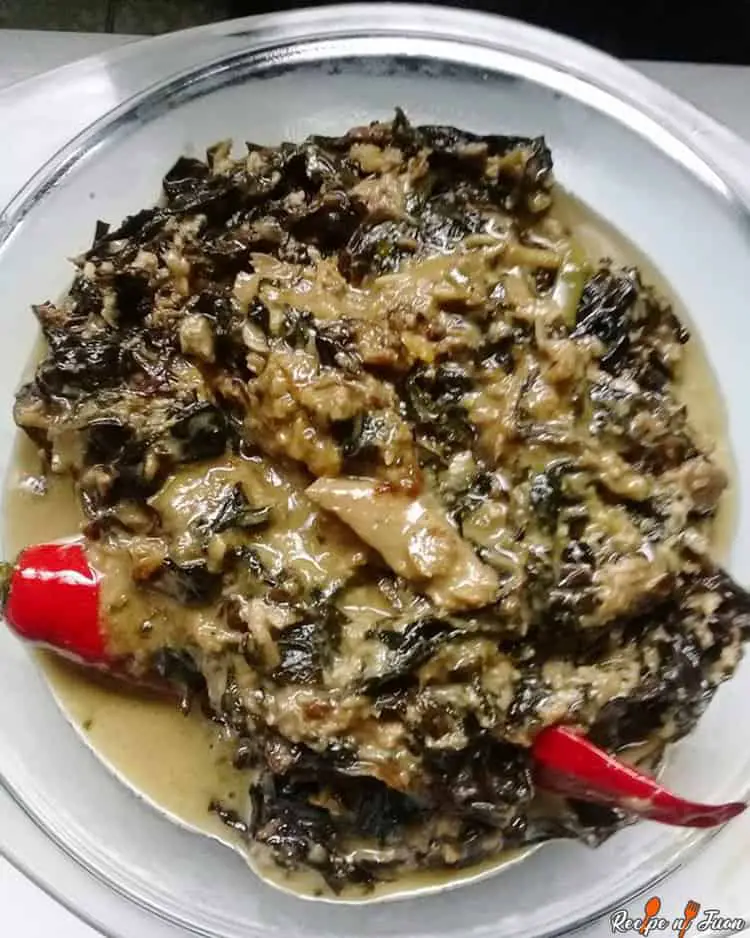
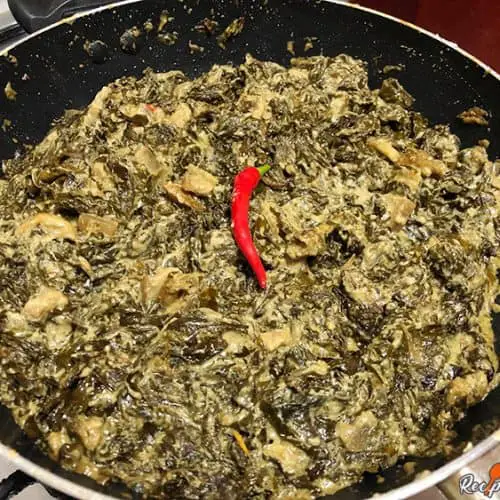
Laing recipe: Filipino dish with taro leaves in coconut milk
Ingredients
- 1 pack (100g) taro leaves or gabi leaves
- 6 cups coconut milk (you can use fresh coconut milk as well)
- 2 cups coconut cream
- ½ cup shrimp paste (bagoong)
- ½ lb pork shoulder thinly sliced
- 7 pcs red chilies
- 1 medium onion sliced
- ½ cup sliced ginger
- 8 cloves garlic crushed
Instructions
- Mix the coconut milk, pork, ginger, shrimp paste, onion, and garlic in a pot. Heat and once the mixture starts to boil, gently stir to mix the ingredients.
- Cover the pot and simmer for 15 to 20 minutes. Make sure to stir once in a while to prevent the ingredients from sticking to the bottom of the pot.
- Add the dried taro leaves but don't stir. Leave it alone until the leaves absorb the coconut milk (this takes about 20 to 30 minutes). You can gently push the leaves down so that they can absorb more coconut milk.
- Once the leaves absorb the coconut milk, stir the leaves and then continue to cook for 10 minutes.
- Pour the coconut cream into the pot and add the red chilies. Stir and cook for 10 to 12 minutes more.
- Serve.
Nutrition
Check out YouTube user Pinoy Spicy Kusina’s video on making laing:
Also read: Bagoong alamang recipe with pork
Cooking tips
There are some cooking tips and tricks to preparing laing. All you have to do is follow them, as I’ll share them here with you:
- The secret to making your laing creamy is to tone down the heat and let the taro leaves soak up the soup until they sink.
- I love my laing to be extra spicy, so if you too, use bird’s eye chili and cut it to expose its spiciness.
- To prevent itchiness, don’t stir the gabi leaves for the first 15 to 20 minutes of cooking. To soften the leaves, gently press them into the coconut milk.
- If you prefer to have a bit of a seafood taste to your dish, simply replace the pork belly with fresh shrimp.
- I also found that laing eaten on the second day after it’s cooked makes the dish more delicious. So if you want your laing to grow in flavor, then eat it on the second day!
Seems easy, right? Just follow my cooking tips and make your homemade laing with dried taro and coconut milk the best one yet!
Substitutes and variations
Don’t fret if you don’t have all the ingredients. Here are some substitutes and variations that you can use so you can still make delicious laing.
Use dried taro leaves instead of fresh
While you can buy fresh taro or gabi leaves in the wet markets or palengke, the dried versionis also readily available.
These packets of dried taro leaves make cooking and preparing laing more accessible to those living outside of the Philippines.
Use cayenne peppers instead of bird’s eye peppers
Bird’s eye peppers are spicier than cayenne peppers, but that’s if you want your laing to be a bit spicier like I do.
However, if you don’t have bird’s eye peppers available, feel free to use cayenne peppers to add to your mouthwatering laing, and bon appetit!
Use fresh shrimp instead of pork shoulder
Substituting fresh shrimp instead of pork shoulder is perfect for seafood lovers. Simply add the fried shrimp into your pot of laing 10 minutes before it’s cooked.
If you don’t have fresh shrimp available, feel free to use dried fish or tuyo. They’re also a delectable choice that goes well with the laing recipe.
And as for the coconut milk and dried taro leaves, I don’t have any substitutes for those. However, don’t worry; the taro plant or gabi is abundant in the Philippines and if you’re currently outside the country, simply look for it in Asian stores.
How to serve and eat
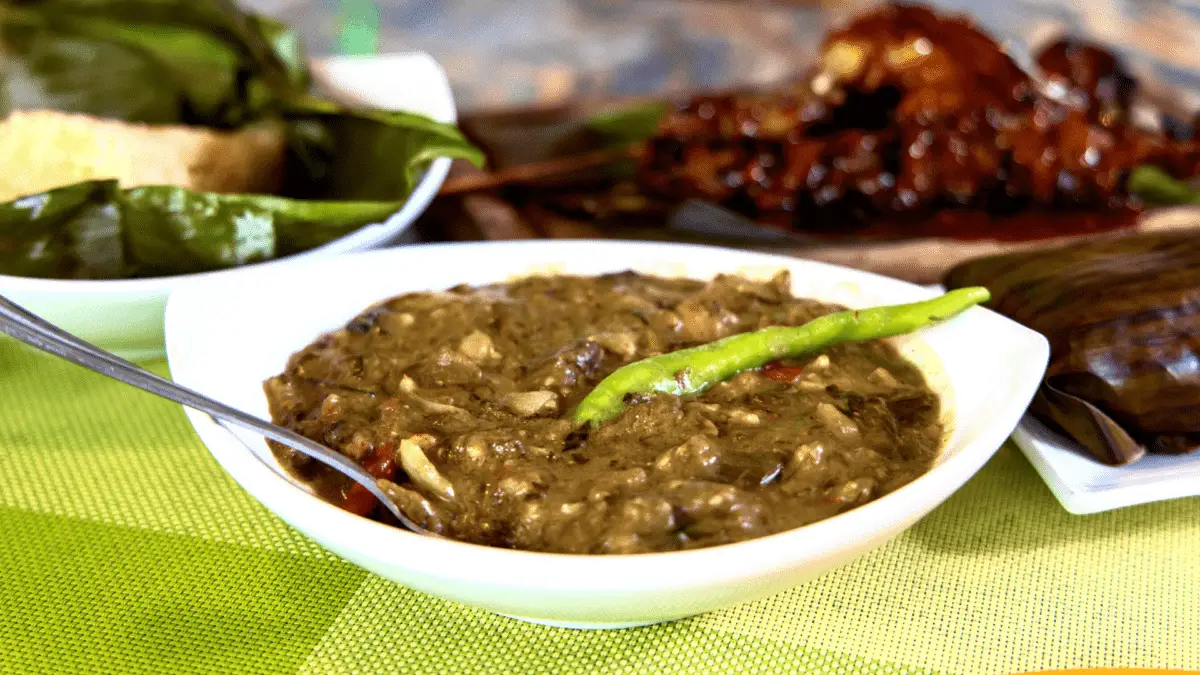
Serving and eating this dish comes easily, just like the way you cook it. Simply transfer your cooked laing into a small bowl and serve the whole family with steamed rice.
You can use a spoon to eat laing and just savor every bite with its creamy sauce and the umami that the pork belly cuts offer.
Share with the whole family and enjoy this dish for breakfast, lunch, or dinner—whenever you like!
Similar dishes
Loving our creamy laing with taro already? There are still more to add to your list of amazing ginataan choices!
Bicol Express
Hot chili peppers are frequently the key element in Bicol Express recipes. Pork, chiles, coconut milk, shrimp paste, onions, and garlic are used to make this spicy recipe. Making it is also simple and quick!
Gising-gising
Gising-gising (sometimes called ginataang sigarilyas) is a fiery Filipino vegetable soup or stew that was first made in the Philippine provinces of Nueva Ecija and Pampanga. Winged beans and coconut milk are usually used in its preparation, which is seasoned with labuyo chile, garlic, onions, and bagoong alamang.
Ginataang talong
Ginataang talong at baboy is another delectable dish made of slow-cooked pork belly and eggplants in coconut milk flavored with onions, garlic, and chilies.
Sinanglay
Sinanglay is another traditional Filipino dish that originated in the Bicol region. It’s made with packed fish wrapped in pandan or lemongrass leaves and served in a hot coconut milk sauce.
FAQs
I know you’re very excited to head to your kitchen and cook laing with taro and coconut milk. But let’s make everything crystal clear first.

Why is laing famous?
Laing is famous not just in Bicol but in the whole Philippines because of its taste that appeals to the Filipinos.
Is laing good for your health?
It’s a great food for enhancing heart health and general wellbeing due to its high fiber and low-calorie content. Cooked taro leaves can be a diverse and nourishing addition to your diet, despite the fact that the leaves can be deadly when eaten raw!
What’s the difference between laing and pinangat?
Most of the Philippines refer to the dish as “laing”, but its original home in Bicol calls it “pinangat” more frequently. So there’s no actual difference!
How do you reheat laing?
Place your laing ulam in simmering water from a frozen container and cook for 8 to 10 minutes, or until thoroughly heated. In order to ensure equal cooking, you can alternatively reheat in a frying pan over low to medium heat.
Are taro and gabi the same?
Yes, taro and gabi are the same. The taro plant has many names, depending on where you’re located. For instance, taro is called “natong”, “katnga”, or “gaway” in Bicol, and “aba” or “awa” in the Ilocos region.
Enjoy your homemade laing now
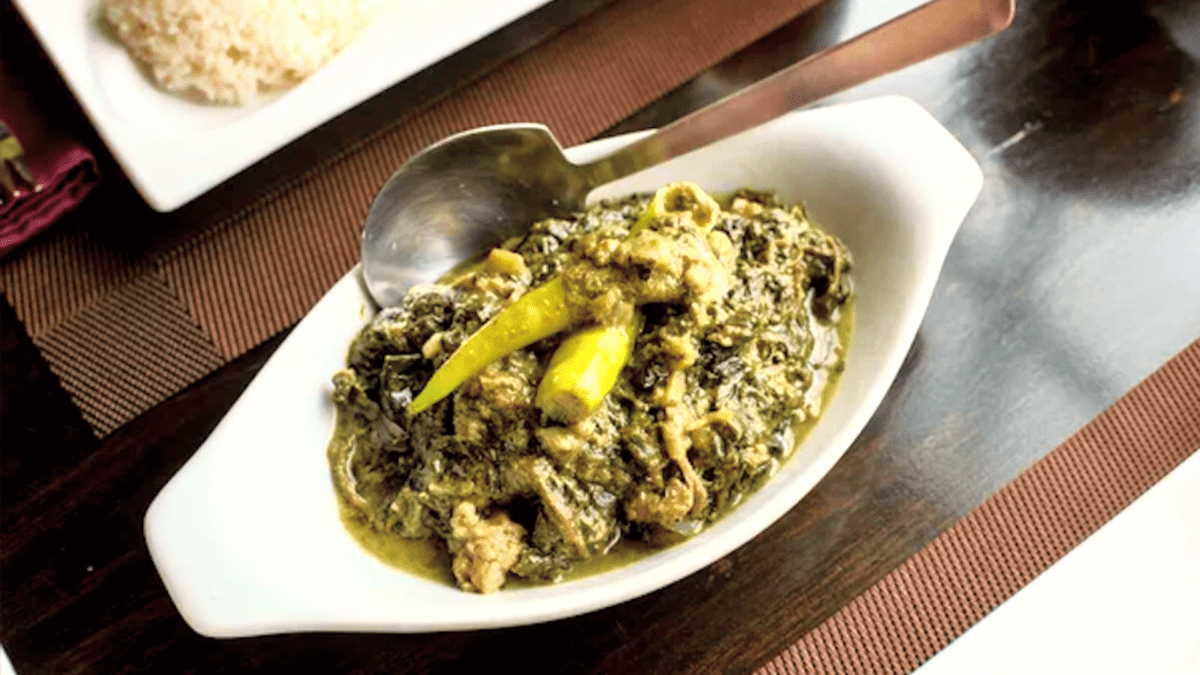
If you’re craving something creamy that’s also nutritious on just about any day, then make your own laing now. Simply gather the ingredients, follow my recipe, and of course, my cooking tips!
It’s easy to make and very economical. It’s no wonder why many Filipino families (even my own) love it so much together with steamed rice.
Ready to take the first bite? Go make your own now!
’til next time.
Did you find my recipe helpful? Please rate it 5 stars and don’t forget to share it with your family and friends as well. Thank you and mabuhay!
If you want to learn more about laing, then read this article.
Check out our new cookbook
Bitemybun's family recipes with complete meal planner and recipe guide.
Try it out for free with Kindle Unlimited:
Read for freeJoost Nusselder, the founder of Bite My Bun is a content marketer, dad and loves trying out new food with Japanese food at the heart of his passion, and together with his team he's been creating in-depth blog articles since 2016 to help loyal readers with recipes and cooking tips.

